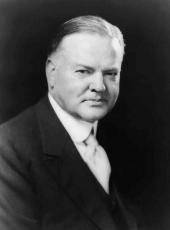RAILROAD CONSOLIDATION
THE PRESIDENT. As the result of meetings of General [William W.] Atterbury, Mr. [Patrick E.] Crowley, Mr. [Daniel] Willard, and the [Mantis J. and Otis P.] Van Sweringens and other representatives of the Pennsylvania, the New York Central, the Nickel Plate, and the Baltimore and Ohio Railroads, a plan for consolidation of the different railways in what is known as the official classification territory--that is, except New England--into four independent systems, was agreed upon for presentation to the Interstate Commerce Commission. The four new systems embrace the territory east of the Mississippi River, including the Virginian Railway on the south, and the New York Central on the north.
These negotiations have been in progress for several weeks. They were undertaken at my suggestion in the hope of effecting the consolidation policies that were declared by Congress in 1920, and especially at this time as a contribution to the recovery of business by enlarging the opportunity for employment and by increasing the financial stability of the railroads, particularly some of the weaker ones.
The Transportation Act [41 Stat. 456], passed by Congress in 1920, provides for the consolidation of the railways into a limited number of strong systems in order to maintain broader competition, more equitable rates, lower operating costs, and in the long run, lower rates to the public.
During the last 10 years the possible grouping of the railroads so as to carry out the law have been under constant discussion. The Interstate Commerce Commission has no power to compel these consolidations. They can only be carried out by the initiative of the carriers themselves. During that time negotiations have been undertaken in respect to those railways on a great number of occasions with view to carrying out the wishes of Congress, but have hitherto all proved abortive. A year ago the Interstate Commerce Commission suggested a plan for consolidating these roads into five systems, but this plan, like the others, met with objections, and has apparently been an unsolvable basis.
The uncertainties and the delays of nearly 10 years have seriously retarded development of the railways--have prevented their desirable growth in many directions, and have diminished their ability to compete with other forms of transportation. Such questions as electrification, the linking up of different railroads, the development of larger terminals, and many offer major improvements have been retarded because of uncertainty with respect to the position which different roads would occupy in the permanent grouping.
It is my understanding that the plan provides for the protection of the interests of the employees and for full consideration of the interests of the various local communities, and fulfills the intent of Congress in the public interest. The presidents of the major systems have agreed upon the many details of the plan, except one minor one, which has been left to arbitration.
The plan, of course, must be submitted to the Interstate Commerce Commission, who have the independent duty to determine if it meets with every requirement of public interest.
That is all this morning.
Note: President Hoover's one hundred and sixty-fourth news conference was held in the White House at 12 noon on Tuesday, December 30, 1930.
On the same day, the White House issued a text of the President's statement on railroad consolidation (see Item 429).
Herbert Hoover, The President's News Conference Online by Gerhard Peters and John T. Woolley, The American Presidency Project https://www.presidency.ucsb.edu/node/211206


